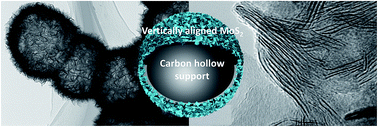Formation of hollow MoS2/carbon microspheres for high capacity and high rate reversible alkali-ion storage†
Abstract
Nanocomposites of carbon and molybdenum disulfide have attracted much attention due to their significant potential in energy conversion and storage applications. However, the preparation of these 0-D MoS2/carbon composites with controllable structures and desirable properties remains a major manufacturing challenge, particularly at low cost suitable for scaling-up. Here, we report a facile solution-based method to prepare porous hierarchical 0-D MoS2/carbon nanocomposites with vertical MoS2 growth on a hollow carbon support, suitable for the electrochemical storage of lithium and sodium ions. The vertically aligned MoS2/hollow carbon material shows excellent performance in the storage of a series of alkali-metal ions (e.g. Li+, Na+, and K+) with high capacity, excellent rate capacity, and stable cyclability. When used for the storage of Li+ ions, it possesses a high capacity of over 800 mA h g−1 at a rate of 100 mA g−1, with a negligibly small capacity decay as low as 0.019% per cycle. At a substantially higher rate of 5 A g−1, this MoS2/carbon nanocomposite still delivers a capacity of over 540 mA h g−1, showing its excellent performance at high rates. Remarkably, this material uniquely delivers high capacities of over 450 mA h g−1 and 300 mA h g−1 for Na+ and K+ ion storage, respectively, which are among the highest values reported to date in the literature. These excellent characteristics confirm the hollow MoS2/carbon nanocomposites to be a primary contender for next generation secondary batteries.

- This article is part of the themed collection: 2018 Journal of Materials Chemistry A HOT Papers


 Please wait while we load your content...
Please wait while we load your content...
